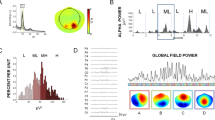Summary
An experiment was carried out to investigate the hypothesis that task difficulty is reflected in changes in the topographical distribution of the ongoing EEG. Subjects had to perform three different tasks at two difficulty levels each; the Sternberg memory scanning task in an auditory and in a visual mode and a task whose performance required mainly visual scanning. Task difficulty was verified by the measurement of response times. Using a commercial Brain Electrical Activity Mapping device, EEG was recorded from 19 scalp electrodes while the subjects performed the tasks. Spectral matrices of the EEG were calculated to investigate spatial relationships in the EEG. Compared to the lower level, higher task difficulty resulted in EEG changes that led to the identification of two factors. One was the reduction of parietal and occipital alpha activity due to the amount of visual scanning and the other an increase of theta activity in the left frontal electrodes which may be associated with the amount of general mental processing.
Similar content being viewed by others
References
Busk, J. and Galbraith, G.C. EEG correlates of visual-motor practice in man. Electroenceph. Clin. Neurophysiol., 1975, 38: 415–422.
Chapman, R.M., Armington, J.C. and Bragden, H.R. A quantitative survey of kappa and alpha EEG activity. Electroenceph. Clin. Neurophysiol., 1962, 14: 858–868.
Duffy, F.H. (Ed.). Topographic mapping of brain electrical activity. Butterworth, Boston, 1986.
Dumas, R. and Morgan, A. EEG asymmetry as a function of occupation, task, and task difficulty. Neuropsychologia, 1975, 13: 219–228.
French, C.C. and Beaumont, J.G. A critical review of EEG coherence studies of hemispheric function. International Journal of Psychophysiology, 1984, 1: 241–254.
Gale, A., Davis, I. and Smallbone, A. Changes in the EEG as the subject learns to recall. Biological Psychology, 1978, 6: 169–179.
Galin, D., Johnstone, J. and Herron, J. Effects of task difficulty on EEG measures of cerebral engagement. Neuropsychologia, 1978, 16: 461–472.
Gasser, T., Bächer, P. and Möcks, J. Transformations towards the normal distribution of broad band spectral parameters of the EEG. Electroenceph. Clin. Neurophysiol., 1982, 53: 119–124.
Gevins, A.S. and Schaffer, R.E. A critical review of electroencephalographical (EEG) correlates of higher cortical functions. CRC Critical Reviews in Bioengineering, 1980, 4: 113–164.
Gevins, A.S., Bressler, S.L., Morgan, N.H., Cutillo, B.A., White, R.M., Greer, D.S. and Illes, J. Event-related covariances during a bimanual visuomotor task. I. Methods and analysis of stimulus and response-locked data. Electroenceph. Clin. Neurophysiol., 1989, 74: 58–75.
Gevins, A.S., Cutillo, B.A., Bressler, S.L., Morgan, N.H., White, R.M., Illes, J. and Greer, D.S. Event-related covariances during a bimanual visuomotor task. II. Preparation and feedback. Electroenceph. Clin. Neurophysiol., 1989, 74: 147–160.
Glass, A. Comparison of the effect of hard and easy mental arithmetic upon blocking of the occipital alpha rhythm. Quartely Journal of Experimental Psychology, 1966, 18: 142–152.
Hjorth, B. An on-line transformation of EEG scalp potentials into orthogonal source derivations. Electroenceph. Clin. Neurophysiol., 1975, 39: 526–530.
Hjorth, B. Source derivation simplifies topographical EEG interpretation. American Journal of EEG Technology, 1980, 20: 121–132.
Kirk, R.E. Experimental design. Brooks/Cole Publishing Company, Monterey, CA, 1982.
Kramer, A.F., Sirevag, E.J. and Braune, R. A psychological assessment of operator workload during simulated flight missions. Human Factors, 1987, 29: 145–160.
Ishihara, T. and Yoshii, N. Multivariate analytic study of EEG and mental activity in juvenile delinquents. Electroenceph. Clin. Neurophysiol., 1972, 33: 71–80.
Israel, J.B., Chesney, G.L., Wickens, C.D. and Donchin, E. P300 and tracking difficulty: Evidence for multiple resources in dual-task performance. Psychophysiology, 1980, 17: 259–273.
Lang, M., Lang, W., Diekmann, V. and Kornhuber, H.H. The frontal theta rhythm indicating motor and cognitive learning. In: R. Johnson, J.W. Rohrbaugh and R. Parasuraman (Eds.), Current Trends in Event-Related Potential Research (EEG Suppl. 40), 1987, 322–327.
McCallum, W.C., Cooper, R. and Pocock, P.V. Brain slow potential and ERP changes associated with operator load in a visual tracking task. Electroenceph. Clin. Neurophysiol., 1988, 69: 453–468.
Mizuki, Y., Tanaka, M., Isozaki, H., Nishijima, H. and Inanaga, K. Periodic appearance of theta rhythm in the frontal midline area during performance of a mental task. Electroenceph. Clin. Neurophysiol., 1980, 49: 345–351.
Nunez, P.L. Electrical fields of the brain. Oxford University Press, New York, 1981.
Oldfield, R.C. The assessment and analysis of handedness; the Edinburgh Inventory. Neuropsychologia, 1971, 9: 97–113.
Pigeau, R., Hoffmann, R., Purcell, S. and Moffitt, A. The effect of endogenous alpha on hemispheric asymmetries and the relationship of frontal theta to sustained attention. AGARD Conference Proceedings No. 432, 1988: 20-1 – 20-16.
Polich, J. and Lawson, D. Event-related potential paradigms using tin electrodes. American Journal of EEG Technology, 1985, 25: 187–192.
Ritter, W., Simson, R., Vauhan, H. and Macht, M. Manipulation of event-related potential manifestation on information processing stages. Science, 1979, 203: 1358–1361.
Shingledecker, C.A. A task battery for applied human performance assessment research. AFAMRL-TR-84-071, Wright-Patterson AFB, Dayton, Ohio, 1984.
Sternberg, S. Memory-scanning: Mental processes revealed by reaction-time experiments. American Scientist, 1969, 4: 421–457.
Surwillo, W.W. Interhemispheric EEG differences in relation to short-term memory. Cortex, 1971, 7: 246–253.
Vogel, F. Grundlagen und Bedeutung genetisch bedingter Variabilität des normalen menschlichen EEG. Zeitschrift für EEG-EMG, 1986, 17: 173–188.
Wertheim, A.H. Occipital alpha activity as a measure of retinal involvement in oculomotor control. Psychophysiology, 1981, 18: 432–439.
Wickens, C., Kramer, A., Vanasse, L. and Donchin, E. Performance of concurrent tasks: a psychophysiological analysis of the reciprocity of information-processing resources. Science, 1983, 221: 1080–1082.
Author information
Authors and Affiliations
Additional information
This work was done while one of the authors (A.G.) held a National Research Council-AFSC Research Associateship. This research was also supported by a grant from the Air Force Office of Scientific Research.
Rights and permissions
About this article
Cite this article
Gundel, A., Wilson, G.F. Topographical changes in the ongoing EEG related to the difficulty of mental tasks. Brain Topogr 5, 17–25 (1992). https://doi.org/10.1007/BF01129966
Accepted:
Issue Date:
DOI: https://doi.org/10.1007/BF01129966




